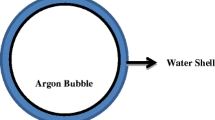Abstract
Single-bubble sonoluminescence (SBSL) is achieved with strong stability in sulfuric acid solutions. Bubble dynamics and the SBSL spectroscopy in the sulfuric acid solutions with different concentrations are studied with phase-locked integral stroboscopic photography method and a spectrograph, respectively. The experimental results are compared with those in water. The SBSL in sulfuric acid is brighter than that in water. One of the most important reasons for that is the larger viscosity of sulfuric acid, which results in the larger ambient radius and thus the more contents of luminous material inside the bubble. However, sonoluminescence bubble’s collapse in sulfuric acid is less violent than that in water, and the corresponding blackbody radiation temperature of the SBSL in sulfuric acid is lower than that in water.
Similar content being viewed by others
References
Gaitan D F, Crum L A, Church C C, et al. Sonoluminescence and bubble dynamics for a single, stable, cavitation bubble. J Acoust Soc Am, 1992, 91: 3166–3183[DOI]
Barber B P, Hiller R A, Löfstedt R, et al. Defining the unknowns of sonoluminescence. Phys Rep, 1997, 281: 65–144[DOI]
Vazquez G, Camara C, Putterman S J, et al. Blackbody spectra for sonoluminescing hydrogen bubbles. Phys Rev Lett, 2002, 88: 197402 [DOI]
Taleyarkhan R P, West C D, Cho J S, et al. Evidence for nuclear emissions during acoustic cavitation. Science, 2002, 295: 1868–1873 [DOI]
Taleyarkhan R P, West C D, Lahey R T, et al. Nuclear emissions during self-nucleated acoustic cavitation. Phys Rev Lett, 2006, 96: 034301[DOI]
Flannigan D J, Suslick K S. Plasma formation and temperature measurement during single-bubble cavitation. Nature, 2005, 434:52–55[DOI]
Hopkins S D, Putterman S J, Kappus B A, et al. Dynamics of a sonoluminescing bubble in sulfuric acid. Phys Rev Lett, 2005, 95: 254301[DOI]
Toegel R, Luther S, Lohse D. Viscosity destabilizes sonoluminescing bubbles. Phys Rev Lett, 2006, 96: 114301[DOI]
Xu J F, Chen W Z, Xu X H, et al. Investigation on the compositions and their evolutions inside a sonoluminescing bubble by spectra. Phys Rev E, 2007, 76: 026308[DOI]
Huang W, Chen W Z, Liu Y N, et al. Precise measurement technique for the stable acoustic cavitation bubble. Chin Sci Bull, 2005, 50(1):1–5[DOI]
Wang W J, Chen W Z, Lu M J, et al. Bubble oscillations driven by aspherical ultrasound in liquid. J Acoust Soc Am, 2003, 114:1899–1904
Hiller R, Putterman S J, Barber B P. Spectrum of synchronous picosecond sonoluminescence. Phys Rev Lett, 1992, 69(8): 1182–1184 [DOI]
Huang W, Chen W Z, Liu Y N, et al. The evolution of the cavitation bubble driven by different sound pressure. Ultrasonics, 2006, 44:e407–e410[DOI]
Author information
Authors and Affiliations
Corresponding author
Additional information
Supported by the National Natural Science Foundation of China (Grant Nos. 10434070 and 10704037) and the Ministry of Education Priorities Project of China (Grant No. 103078)
Rights and permissions
About this article
Cite this article
Huang, W., Chen, W., Gao, X. et al. Comparison between the single-bubble sonoluminescences in sulfuric acid and in water. Sci. China Ser. G-Phys. Mech. Astron. 52, 184–188 (2009). https://doi.org/10.1007/s11433-009-0026-0
Received:
Accepted:
Published:
Issue Date:
DOI: https://doi.org/10.1007/s11433-009-0026-0




